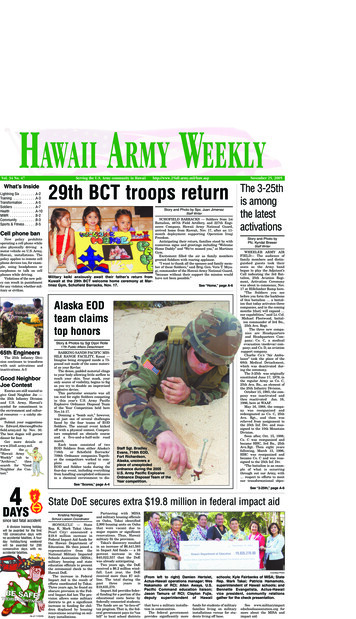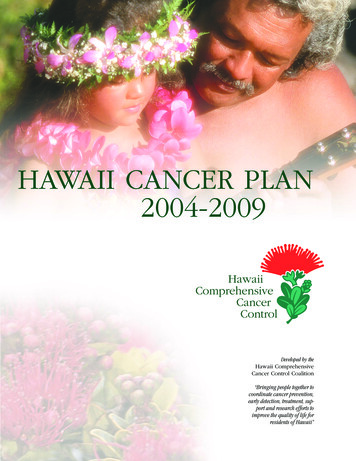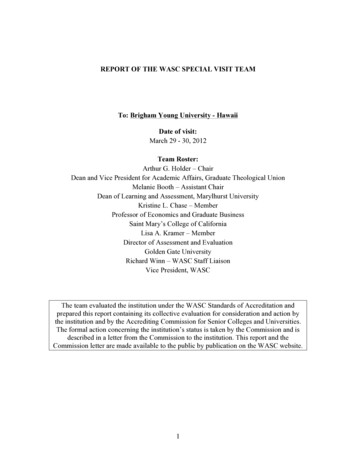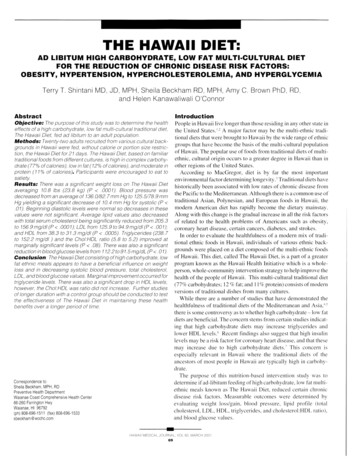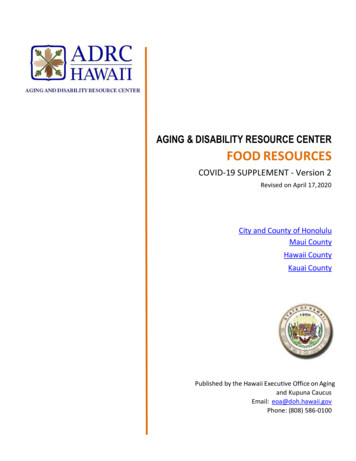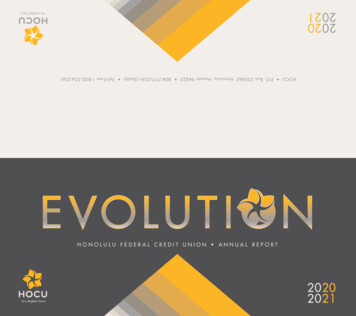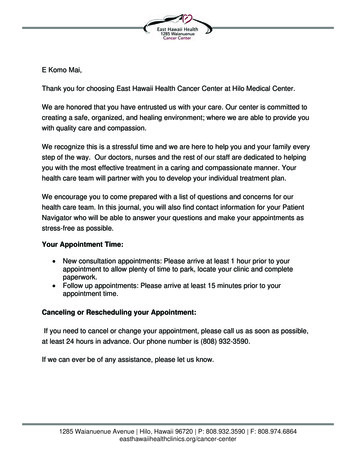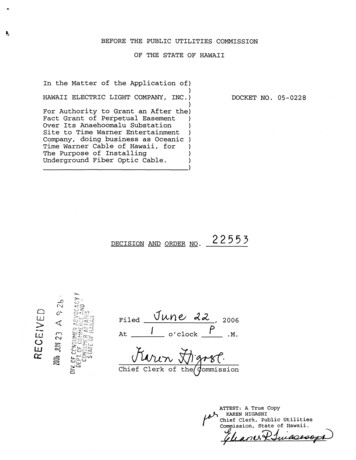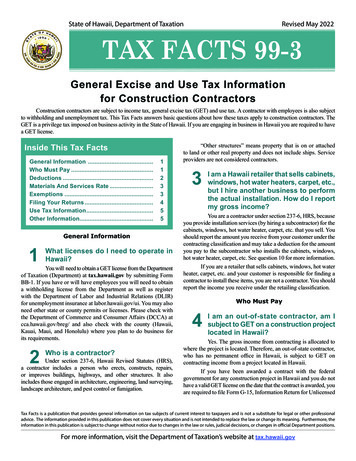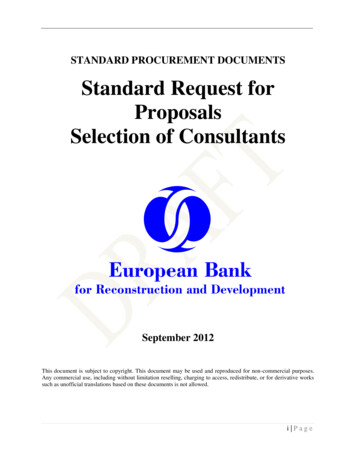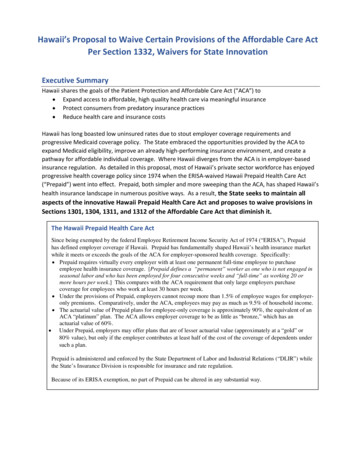
Transcription
Hawaii’s Proposal to Waive Certain Provisions of the Affordable Care ActPer Section 1332, Waivers for State InnovationExecutive SummaryHawaii shares the goals of the Patient Protection and Affordable Care Act (“ACA”) to Expand access to affordable, high quality health care via meaningful insurance Protect consumers from predatory insurance practices Reduce health care and insurance costsHawaii has long boasted low uninsured rates due to stout employer coverage requirements andprogressive Medicaid coverage policy. The State embraced the opportunities provided by the ACA toexpand Medicaid eligibility, improve an already high-performing insurance environment, and create apathway for affordable individual coverage. Where Hawaii diverges from the ACA is in employer-basedinsurance regulation. As detailed in this proposal, most of Hawaii’s private sector workforce has enjoyedprogressive health coverage policy since 1974 when the ERISA-waived Hawaii Prepaid Health Care Act(“Prepaid”) went into effect. Prepaid, both simpler and more sweeping than the ACA, has shaped Hawaii’shealth insurance landscape in numerous positive ways. As a result, the State seeks to maintain allaspects of the innovative Hawaii Prepaid Health Care Act and proposes to waive provisions inSections 1301, 1304, 1311, and 1312 of the Affordable Care Act that diminish it.The Hawaii Prepaid Health Care ActSince being exempted by the federal Employee Retirement Income Security Act of 1974 (“ERISA”), Prepaidhas defined employer coverage if Hawaii. Prepaid has fundamentally shaped Hawaii’s health insurance marketwhile it meets or exceeds the goals of the ACA for employer-sponsored health coverage. Specifically: Prepaid requires virtually every employer with at least one permanent full-time employee to purchaseemployee health insurance coverage. [Prepaid defines a “permanent” worker as one who is not engaged inseasonal labor and who has been employed for four consecutive weeks and “full-time” as working 20 ormore hours per week.] This compares with the ACA requirement that only large employers purchasecoverage for employees who work at least 30 hours per week. Under the provisions of Prepaid, employers cannot recoup more than 1.5% of employee wages for employeronly premiums. Comparatively, under the ACA, employees may pay as much as 9.5% of household income. The actuarial value of Prepaid plans for employee-only coverage is approximately 90%, the equivalent of anACA “platinum” plan. The ACA allows employer coverage to be as little as “bronze,” which has anactuarial value of 60%. Under Prepaid, employers may offer plans that are of lesser actuarial value (approximately at a “gold” or80% value), but only if the employer contributes at least half of the cost of the coverage of dependents undersuch a plan.Prepaid is administered and enforced by the State Department of Labor and Industrial Relations (“DLIR”) whilethe State’s Insurance Division is responsible for insurance and rate regulation.Because of its ERISA exemption, no part of Prepaid can be altered in any substantial way.
DRAFTCharacteristics of Hawaii and Its Health Insurance MarketWith an ethnically diverse 1.4 million population spread across six main islands, Hawaii is one of thesmaller and most geographically isolated states in the nation. Tourism, government, and military activityare dominant elements in Hawaii’s economy. While more individuals are employed by large employers,the vast majority of private employers are small businesses with fewer than 50 employees.Reflecting its population size, Hawaii has a small insurance marketplace. Since the founding of the HawaiiMedial Service Association (“HMSA”) in 1935 and the entry of Kaiser Foundation Health plan (“Kaiser”) tothe market in 1958, Hawaii has been a unique marketplace for health insurance carriers. Adding to thestate’s singular character is the fact that all five of the health plans in Hawaii that serve small employers University Health Alliance, Hawaii Management Alliance Association, Family Health Hawaii, Kaiser, andHMSA - are not-for-profit organizations.Underpinning Hawaii’s unique market structure is the 40-year-old Prepaid, which requires nearly allemployers to provide a uniformly high level of coverage for their employees. It also requires employees toaccept the offered coverage unless they can demonstrate coverage from another source (a spouse’s plan,for example). The Prepaid model manages the richness of benefits by identifying the prevalent PPO andHMO benefit packages in the state and making those packages the floor for benefit coverage. As a result,the benefit plans sold to employers in the state have an average actuarial value of 90% (essentiallyequivalent to a platinum plan in ACA parlance). Even with these robust benefit plans, employees enjoyprotection from significant premium contributions as Prepaid limits premium contributions to only 1.5% ofthe employees’ wages for employee-only coverage. While employer-based coverage in Hawaii is richerthan required under the ACA and employer contributions are smaller, small employers and theiremployees are also protected by the state’s rating approval process and the Prepaid requirement thatcarriers cannot refuse to insure an employer group. Hawaii’s health care system does suffer from some ofthe same concerns related to access, quality, and cost as the rest of the country; however, the regulatoryconsistency of benefits under Prepaid with the state’s small market and limited number of insurers, havecombined to increase system stability and predictability while limiting entrepreneurial medical care thatadds cost with little value to the health care market.Besides employer-based insurance, Hawaii has sought to ensure coverage by means of progressive publicinsurance strategies. In the early 1990s, Hawaii created a basic State Health Insurance Program (“SHIP”)for the insurance “gap group,” and, in 1994, Hawaii received one of the first section 1115 Medicaidwaivers that incorporated the SHIP program and ambitiously aimed at universal insurance coverage.Although the 1115 waiver was not able to achieve this goal, the State has taken advantage of the ACA toexpand eligibility, and strongly advocates for individuals not otherwise covered to obtain affordableinsurance through a Supported State-Based Marketplace. Before 2014 when ACA coverage becameavailable, Hawaii’s uninsured rate was estimated to be 100,000 people, mostly non-elderly adults. Now,having the experience of two years of expanded ACA enrollment opportunities, Hawaii’s uninsured rate isthought to be less than half that number.Health insurance coverage and Prepaid are not the only factors that contribute to a healthier populationand more efficient system but we believe they are linked to Hawaii’s superior performance, as comparedto the national measures sampled below:Hawaii ACA Innovation Waiver Proposal – DRAFT September 4, 20152
DRAFT 10% lower employer-sponsored premiums for families (2013) 193% of residents with a usual source of care (2012) 243% fewer hospitalizations per 100,000 adults (2011) 332% fewer emergency room visits per 1000 (2011) 4Healthiest state in the nation (2015) and among the top ten since surveying began in 2008 5The following table illustrates how Hawaii residents are covered by health insurance type.Insurance Coverage by TypeEmployer-sponsored – Private SectorEmployer-sponsored – State/CountyMedicaid/CHIPMedicareTricare and MilitaryIndividualUninsuredPercentage of Population29%13%23%16%12%3-4%3-5%Implementation of a State-Based Marketplace and Lessons LearnedWith Hawaii’s progressive agenda for full insurance coverage and its long-standing success with Prepaid,the State was among the first to declare its intent to create an ACA state-based marketplace. Despitesubstantial federal investment in technology and assistance, the efforts of the non-profit corporationformed to establish the marketplace, years of significant work contributed by public-sector employeesfrom at least five departments, and a supportive legislature, the Hawaii Health Connector (“Connector”)was not sustainable. As a result of our lessons learned: With the November 2015 open enrollment period, Hawaii became a Supported State-BasedMarketplace Hawaii’s SHOP infrastructure was shut down, and small employers enrolled directly with healthplans as of June 2015 Hawaii is seeking to waive SHOP in 2017Specific lessons learned from our experience are the following:1. Start-up and upkeep too expensive for small market. As events proved, Hawaii’s population wasnot large enough to make the development and upkeep of its own marketplace financially viable.With 1.4 million total residents, Hawaii’s uninsured population was estimated to be only 100,000in 2013, and fewer than 170,000 people worked for small employers (50 employees or fewer).The Connector, of necessity, was technically complex and expensive to develop and maintain;consequently, its infrastructures costs could not be scaled down to fit a limited market.1Medicaid Expenditures Panel Survey-Insurance Component. Average annual family premiums for Hawaii and theUS were 14,382 and 16,029, respectively.2State Health Access Data Assistance Center (“SHADAC”) analysis of restricted National Health Interview Survey(NHIS) data.3SHADAC analysis of Healthcare Cost and Utilization Project (HCUP) data.4Kaiser State Health Facts analysis of American Hospital Association data.5Gallup-Healthways Physical Well-being Index.Hawaii ACA Innovation Waiver Proposal – DRAFT September 4, 20153
DRAFT2. Connector systems too complex and susceptible to errors. As a “start-up” effort, the Connectorwas unable to inspire confidence in its operations for individual consumers, employers, orinsurers. It was able to improve its customer-facing services, but was never able to effectivelymanage “back-office” functions, which created coverage lags and significant frustration for bothconsumers and insurers. The Connector was able to increase its volume of individual enrolleessomewhat during the second year of business, but it was never able to persuade even 1% ofeligible small businesses to use its services.3. Small businesses purchased coverage as they always had done under Prepaid. Notwithstandingoutreach, marketing, and a significant effort among business organizations to educate smallemployers about potential tax credits, fewer than 250 small employers enrolled through theConnector. This amounts to less than 1% of employers with 25 or fewer employees. Smallemployers did not make the switch because: Unlike in the rest of the country, small employers were already buying coverage for theiremployees due to Prepaid requirements. After years of purchasing directly from plans orvia agents or brokers, there was little interest in testing a new route. Initially two and then only one insurer offered plans on the Connector SHOP marketplace.Meanwhile, outside of the Connector, small employers had the choice of five commercialplans selling the same products.4. No competition. The Connector was unable to foster competition among carriers. Only two offive commercial insurers initially offered individual plans and, in the second year, only one insurerprovided small business plans in SHOP. Hawaii’s other commercial plans were not incentivized toparticipate in the Connector because of the premium fees and the additional filings and reporting.Proposed Waiver: Conforming the Small Employer Marketplace to PrepaidHawaii proposes to adjust its health insurance marketplace by means of the proposed waiver to align theACA and Prepaid for small employers. Hawaii does not propose any changes to the marketplace forindividuals, who will continue to have full access to coverage and any subsidies to which they are entitledin a Supported State-Based Marketplace.As noted above, Prepaid provides predictable coverage and relatively stable prices for small businessesand their employees. Employees enjoy significantly greater benefits under Prepaid than required underthe ACA. Among the differences:Prepaid Employers with even a single permanentemployee must provide coverage. Permanent employees are eligible forcoverage if they work 20 hours or more perweek. The actuarial value of Prepaid plans averages90%, and may not dip below 80%.ACA Only large employers must provideemployee coverage. Permanent employees are eligible forcoverage if they work 30 hours or more perweek. Employers may offer plans with an actuarialvalue as low as 60%.Hawaii ACA Innovation Waiver Proposal – DRAFT September 4, 20154
DRAFT Employees cannot be made responsible forpremium costs that exceed 1.5% of wages. Employees may pay as much as 9.5% ofhousehold income.Under the State’s proposal, both individual and small business coverage would retain the Essential HealthBenefit package. Individuals would have a greater array of options to meet their needs including thegamut of metal levels, bronze through platinum, catastrophic plans for eligible individuals, and child-onlyplans while small employers, conforming to Prepaid, would continue to offer plans with an averageactuarial value of at least 80%.The State emphasizes the two following facts that should be given significant consideration bythe Secretary:1. In contrast to the ACA, small employers in Hawaii do provide employee coverage, whichincludes the EHBs and additional mandated services, and employees pay little of thecost. SHOP adds nothing in terms of value or incentives and has served only to increasesmall business insurance costs.2. Prepaid works and has been working for more than forty years with minimal publicinvestment in infrastructure for data collection, monitoring, reporting, and penalties.Besides maintaining the superior benefits for employees required by Prepaid, Hawaiirequests a SHOP waiver to ensure the effective cooperation among insurers, employees,employers, and State agencies that has enjoyed an exemplary level of compliancewithout adding significantly to administrative costs.The specific sections for which Hawaii requests a waiver and the reason for each request are outlinedbelow:ACA Section§1301 (a)(1)(C)(ii)Qualified health insuranceissuer must offer at least onequalified health plan in thesilver level§1301 (a)(2)Inclusion of co-op and multistate qualified health plans.§1304 (b)(4)(D)(i) and (ii)Continuation of participationfor growing small employers§1311 (b)(1)(B)The establishment of a SmallBusiness Health OptionsProgram (SHOP Exchange)Reason Waiver is SoughtWhile Hawaii supports this provision for the individual marketplace,requiring a qualified health plan to provide a silver level plan is notconsistent with Prepaid and therefore not consistent with our requestto waive SHOP.Hawaii proposes to waive this section as it is doubtful that co-op andmulti-state plans can conform to the requirements of Prepaid. Inaddition, plans would be harder to regulate and monitor forcompliance than state-based plans.As Hawaii is proposing to waive SHOP so it follows that the Stateproposes to waive this provision, which would allow a “growing smallemployer” to continue to enroll employees through the exchange.Hawaii proposes to waive SHOP for three important reasons:1. In order to make clear to all small employers in the state thenecessity to continue to meet Prepaid rather than ACArequirements; and2. To eliminate the burdensome expensive, unnecessaryinfrastructure required by the ACA for SHOP functions.Hawaii ACA Innovation Waiver Proposal – DRAFT September 4, 20155
DRAFT§1311 (f)(3)(B)Eligible entity authorized tocarry out exchangeresponsibilities§1312 (a)(2)Employer may specify leveland employee may chooseplans within a level§1312 (f)(2)(A)Definition of “qualifiedemployer”[Section Citation]Definition of eligibleemployee as one who works30/more hours/weekMaintaining these state-based SHOP functions is not economicallyfeasible, fails to add value to the Hawaii marketplace, and, in fact,imperils the success of Hawaii’s cost-effective system; and3. To relieve small employers of the added premium costs related topurchasing ACA plans on the SHOP.While Hawaii values the opportunity to partner with the federalexchange to ensure individual coverage, the unique requirements ofPrepaid cannot be adequately supported by the federal exchangeinfrastructure.Hawaii proposes to waive these sections to permit flexibility as towhich state agencies, in addition to the Medicaid agency, can carryout responsibilities for the individual exchange.Hawaii proposes to waive the consumer choice provision defined inthis section in conjunction with waiving SHOP. Supporting reasonsare:1. Assuring such choice for employees of small businesses requiresan on-going investment in technical infrastructuredisproportionate to the benefits for Hawaii’s small market.2. The cost to comply with the technical infrastructure necessary tooffer consumer choice for insurers offering coverage tobusinesses would result in the smaller insurers departing themarket and so achieve the unintended consequence of reducedcompetition and choice. It should be noted that when theConnector supported the SHOP exchange, it included only Kaisersmall business plans, so consumer choice was foiled by the lack ofcompetitors.3. In Hawaii’s Prepaid environment, consumer choice is relativelyinsignificant because employers are required to purchaseemployee coverage with uniformly comprehensive benefits withvery little of the cost passed on to employees.4. Offsetting any consumer disadvantages is the fact that employeeaccess to coverage, benefits, and cost-sharing are significantlybetter under Prepaid than under the ACA provisions.As Hawaii proposes to waive SHOP, there will be no “qualifiedemployers” that may elect to make employees eligible to purchaseinsurance coverage through the exchange.Hawaii proposes to waive the ACA definition of “full-time” employeein favor of the definition in Prepaid. The ACA defines such employersas those working at least 30 hours per week while Prepaid coversthose regularly working 20 or more hours per week.Description of Waiver ProgramIn describing the proposed waiver, the State is describing how Hawaii’s small employer market functionsin accordance with Prepaid, which requires all businesses with at least one employee working a minimumof 20 hours per week to provide health insurance. It should be emphasized that Hawaii’s employerHawaii ACA Innovation Waiver Proposal – DRAFT September 4, 20156
DRAFTsponsored health insurance market is the only market regulated by Prepaid. Prepaid is consistent with orexceeds the ACA in all the following aspects: Strong employee protections from out-of-pocket costs Employer participation from the smallest to the largest businesses A forum in which employers can select from among competing health plans Standardized, meaningful benefit requirements Actuarial values for plans that meet or exceed ACA requirements Minimal risk of adverse selection due to Prepaid’s broad coverage mandate and long history of uptake (in fact, a SHOP exchange environment likely presents a greater risk of uncertainty, adverseselection, and a corresponding need for risk corridor payments in the small group market)Prepaid works because of the cooperative interactions of the parties involved, including employers andemployees, insurers, and regulatory agencies, notably the DLIR and the State’s Insurance Division, asoutlined below:The Insurance Commissioner/Insurance Division. The Insurance Commissioner (“Commissioner”) isresponsible for reviewing health insurance plans to ensure that their benefit structures comply withapplicable state and federal law, including providing state-mandated benefits and Essential HealthBenefits for ACA-compliant plans, both for the individual market and for the small employer market.The Commissioner also reviews and rules on health insurance rate proposals according to the processprescribed in Hawaii’s insurance code. Plans are required to file with the Commissioner every rate,charge, classification, schedule, practice or rules, and any modification thereof it proposes to use, alongwith supporting documentation. Mandatory information to be incorporated in the rate filing includes: Medical and prescription drug utilization and claims experience Premium and demographic information Index rate developmentRate filings are open to public inspection during the review period before a filing is approved. The reviewperiod, during which the Commissioner may request additional information, is at least 60 days. A ratebecomes effective if approved by the Commissioner or upon expiration of the review period theCommissioner did not disapprove. If a filing is disapproved by the Commissioner, a petition for acontested case hearing may be filed with the Commissioner within 30 days of the decision. The petitionerhas the burden of proving that the disapproval of the filing is not justified. The Commissioner must affirm,reverse, or modify the previous decision. This, in turn, can be appealed to the Circuit Court and,subsequently, to the State Supreme Court.The Commissioner accepts and adjudicates health insurance complaints. For more information seesection below, “Assuring compliance, reducing waste and fraud.”The Commissioner contributes to transparency and competition by maintaining and posting a listing ofpremium rates for all plans offered to small businesses at rison/.DLIR and the Prepaid Council. The Prepaid statute requires plans to be reviewed for complianceby the Prepaid Healthcare Council (“Council”), a committee of community members who offerrecommendations for plan approval to the Director of DLIR. The Council ensures conformity to theHawaii ACA Innovation Waiver Proposal – DRAFT September 4, 20157
DRAFTmedical and hospital benefits offered by the plan that has the largest number of subscribers in the state.The meetings of the Council are subject to the state’s open meetings law, which requires public notice ofall meetings and allows for public input on all matters before the Council. This review is comparable tothe certification process for QHPs offered through an Exchange.DLIR also administers a Premium Supplementation Fund established as part of Prepaid to provide financialassistance to small businesses that employ fewer than eight employees. This program is described ingreater detail belowEmployer participation. The following excerpt from DLIR’s website provides guidance toemployers for purchasing employee coverage:Employers can choose one of the following three ways to provide the mandated coverageto their employees. Purchase an approved plan [the website provides a link to the list of alreadyapproved plans]. In Hawaii, insurance companies, mutual benefit societies andhealth maintenance organizations can sell health care plans to Hawaii employersdirectly. These plans must be reviewed by the PHC Advisory Council and approvedby the Director of the Department of Labor and Industrial Relations (DLIR) beforethey can be marketed to employers. Purchase an insured plan of employers’ choice. Some employers with corporateoffices located outside of Hawaii purchase a health care plan and offer such planto their employees on a nationwide basis. Employers that choose this option mustsubmit their plan to DLIR for review by the PHC Advisory Council and approval bythe Director to ensure the benefits are comparable to plans sold in Hawaii. Provide a health care plan that is funded by the employer. As a self-insurer, theemployer must show proof of financial solvency and ability to pay benefits byfurnishing DLIR with the latest audited financial statements for review. Followingthe initial approval, the audited financial statements must be filed annually forcontinued approval. Employers choosing this option must complete anapplication for self-insurance [a link to Form HC-61 is included here] as well assubmit a copy of their health care plan to DLIR for review by the PHC AdvisoryCouncil and approval by the Director to ensure the benefits are comparable toplans sold in Hawaii.All health care plans, whether sold by health care contractors or submitted by employers,must be approved by DLIR as meeting the prescribed minimum standards. Suchdetermination is made by the Director under the advisement of a seven-member PHCAdvisory Council consisting of representatives from the medical and public health careprofessions, from consumer interests, and from the prepaid health care protectionindustry. Upon approval, plans are designated as 7(a) or 7(b) plans. Plans designated as7(a) are equal to or better than the benefits offered by the plan with the largest number ofsubscribers (also known as the prevalent plan) in the State of Hawaii. (See the summary ofbenefits offered by the PPO and HMO prevalent plans.) Plans designated as 7(b) provide forsound basic hospital, surgical, medical, and other health care benefits; however, plan’sbenefits, such as, the deductible, out of pocket limit, lifetime maximum benefit, benefit leveland copayments, may be more limited than the benefits provided by plans qualifying as7(a). Plans qualifying as 7(b) require the employer to pay one-half of the cost fordependents’ coverage.Hawaii ACA Innovation Waiver Proposal – DRAFT September 4, 20158
DRAFTEmployers may elect to pay the entire monthly premium or share the cost with theiremployees. Employers must pay at least 50% of the premium cost, but the employees’ sharecannot exceed the lesser of 50% of the premium cost or 1.5% of the employees’ monthlygross earnings. Cost sharing for dependents is determined by plan type. If employerspurchase an approved plan, the health care contractor is responsible for informing theemployers whether they are responsible for contributing toward dependents’ coverage. Ifemployers submit a plan for approval, DLIR is responsible for informing the employers oftheir plan approval designation and whether they are responsible for contributing towarddependents’ coverage.There are situations where employees can waive the mandated coverage. These includebeing covered by a federally established health insurance, such as, Medicare and Medicaid,covered as a dependent under a qualified plan, recipient of public assistance and covered bystate-legislated health plan, covered under their own personal health insurance policy or afollower of a religious group who depends for healing upon prayer or other spiritualmeans. Employees are required to complete “Employee Notification to Employer” [a linkto Form HC-5 is included here] every calendar year to validate the exemption so thatemployers are relieved of the responsibility for providing the mandated health carecoverage.Unless specifically excluded under the law or a Notice to Employer to waive coverage is filedwith the employers, all employees who meet the eligibility requirements are entitled tohealth care coverage through employer-based group policies. Complaints [a link to FormDC-54 is included here] related to non-coverage by employers can be filed with theInvestigation Section in Honolulu or on the neighbor-island, the Department of Labor andIndustrial Relations District Office nearest the complainant for assistance. Complaintsrelated to benefits of the plan are usually filed directly with the health care contractors whoare regulated by the Department of Commerce and Consumer Affairs, Insurance Division.Insurers, agents, and brokers. Small employers may obtain employee insurance directly from thefive insurers offering coverage. Alternatively, all but HMSA work with agents and brokers who alsosupport employers for plan choice and employee enrollment.Tax Credit ProposalIn lieu of the ACA’s small business employer tax credit described in ACA Section 1421, the Stateproposes that funds amounting to 46 million for the five year waiver period be paid to Hawaii.Such funds will be deposited in Hawaii’s Premium Supplementation Fund established by Prepaid(HRS §393-41). While the State’s fund is more narrowly restricted, it serves the same purpose asthe ACA’s small business tax credits and, as it will be locally administered, it is more likely to beused by Hawaii’s small business community.The following table highlights the differences between the ACA’s small business tax creditprogram and the Prepaid Premium Supplementation Fund:Hawaii ACA Innovation Waiver Proposal – DRAFT September 4, 20159
DRAFTACA Small Business Tax Credit Eligibility Small business employs 25 or feweremployees. Business covers at least 50% ofemployee-only insurance cost. Employees must have average annual wagesof less than 50,000 (as adjusted for inflationbeginning in 2014). The maximum credit is 50 percent ofpremiums paid for small businessemployers and 35 percent ofpremiums paid for small tax-exemptemployers. The credit is limited to two consecutivetaxable years to eligible employers. Prepaid PremiumSupplementation Fund EligibilityEmployer employs less than eightemployees entitled to coverage underPrepaid.Employer’s share of premium costs exceeds1.5% of total wages for such employees.The amount that exceeds 1.5% ofwages is greater than 5% of theemployer’s income before taxesdirectly attributable to the business inwhich such employees are employed.The amount of the supplementation isthat part of the employer’s share of thepremium cost which exceeds thespecified 1.5% of wages limitation.We propose the following methodology to calculate the value of the tax credit to be provided to the State:Small Business ACA Tax Credit MethodologyThe total market value of the credits: The estimated value of the small business tax credit sincefrom 2010 is estimated to be 182 million based on full utilization by all eligible employersidentified in 2014 data from the DLIR. This is based on the maximum annual value of the creditsfor each employer multiplied by the number of y
Besides employer-based insurance, Hawaii has sought to ensure coverage by means of progressive public insurance strategies. In the early 1990s, Hawaii created a basic State Health Insurance Program ("SHIP") for the insurance "gap group," and, in 1994, Hawaii received one of the first section 1115 Medicaid
